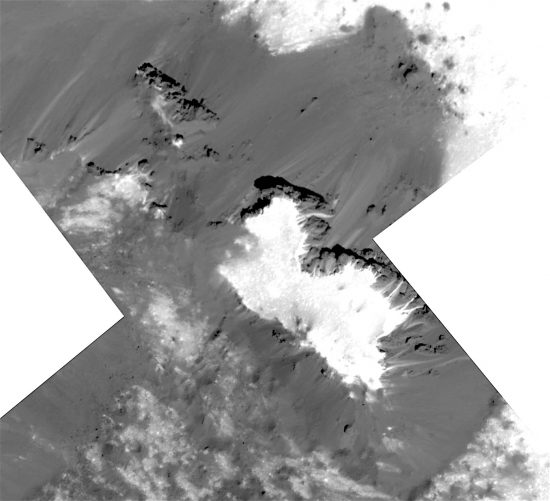
A large mound in Cerealia Facula from an altitude of about 34 kilometers. Note dendritic ridges and scalloped edges. Image Credit: NASA/JPL-Caltech/UCLA/MPS/DLR/IDA. Click to enlarge.
Sep 19, 2018
The mission is winding down.
On September 27, 2007 NASA launched the Dawn spacecraft. After observing the asteroid Vesta, Dawn headed toward Ceres. Dawn encountered the largest known asteroid on March 6, 2015, where it remains in orbit. The mission officially ended in June of 2016, but was extended until the spacecraft runs out of hydrazine maneuvering fuel sometime this month (September 2018), although Dawn will continue orbiting Ceres for a long time—a minimum of 50 years.
Ceres is large enough to be spherical, with a mean diameter of 950 kilometers, It is considered to be a dwarf planet, like Pluto, along with several recently discovered Trans-Neptunian Objects. Its size and density are similar to Saturn’s moons Tethys (1072 kilometers) and Dione (1120 kilometers). With a density of 2.08 g/cm³, it could also be covered with a thick layer of ice. Since it compares with Pluto’s density measurement of 1.88 g/cm³, there might be silicate rock beneath the ice. No one is sure, at this point.
Ceres is a barren wasteland of a world: craters and trenches are carved into its body. Strange, solitary mountains and a scorched, blasted surface resemble other rocky bodies, Mercury, for example. One of those shared features on Mercury is large craters with fractures and furrows running through them. The etched furrows radiating outward from some craters denote untold numbers of electric filaments. On Earth, those filaments would have been the largest lightning strikes ever witnessed.
As previously written, Dr. Cj Ransom created similar formations by exposing a thin layer of magnesium silicate to a 120 milliamp, 12,000 volt discharge for five seconds. He created radial gouges on a small scale equivalent to Mercury (and Ceres) at the large scale.
The craters on Ceres exhibit an arrangement that is patently absurd—nearly every one is aligned with its center of gravity, as if they all impacted at 90 degrees to its surface. As pointed out in previous Pictures of the Day, they have flat floors, scalloped edges, vertical sidewalls, craters on the rims of other craters, hexagonal formations, and crater chains. The crater alignment problem is solved if large craters on Ceres are electrical in nature.
Observations of Ceres add weight to the electrical theory of Solar System formation long proposed by Electric Universe advocates. Moons and planets conform to that theory far better than they do to conventional ideas.
Ceres exhibits what can best be described as a violent past. Whether that past was recent in the history of the Solar System, or more remote in time, is not important. From an Electric Universe perspective, what is important is the reason why Ceres (and Mercury and the Moon) appears to be so devastated.
Stephen Smith












